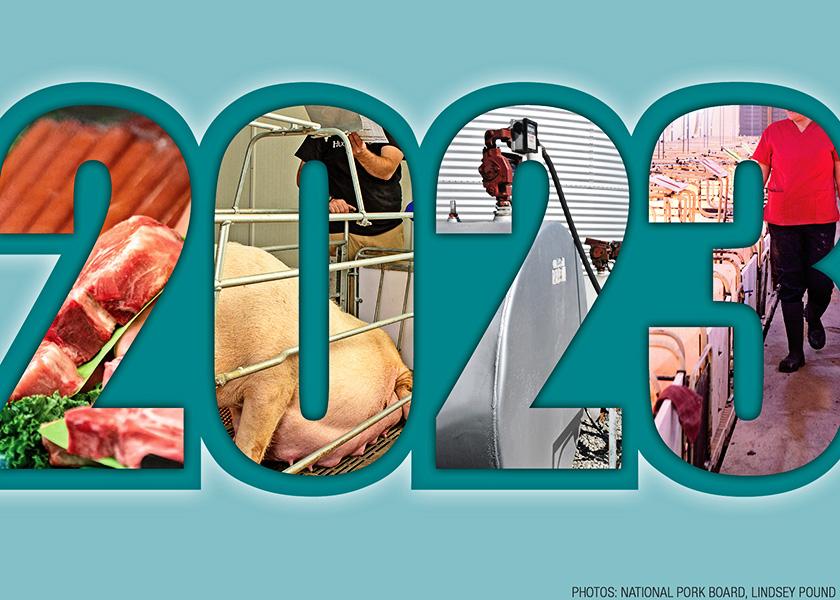What’s Driving the Pork Industry in 2023?

By Caleb Shull, director of research and innovation for The Maschhoffs
I’m probably not the only one who has wondered when things will go back to normal. If there is such a thing as “normal,” I am not sure we will see it in 2023. The coming year should bring clarity on key issues such as the Proposition 12 ruling and the status of gene editing within our industry. Both issues are pivotal with the potential to reshape our industry. Several other challenges lie ahead in the coming year, such as a looming recession, elevated input prices and ongoing pig health challenges. Still, the U.S. pork industry remains in a good position and there are reasons to be hopeful about what’s ahead.
Supply and Demand
Pork demand continues to follow a roller coaster ride with some positive signs for global demand countered with fears of prolonged recession due to inflation and its impact on consumer behavior. Although the demand picture might be murky and somewhat pessimistic, the supply outlook in the U.S. gives producers hope.
In recent years, supply has been outpacing demand, which has led to limited opportunities for producer profitability and ultimately tightening supply. Fortunately, demand for U.S. pork supported prices throughout most of 2022. History tells us periods of high prices lead to increased supply. However, history does not seem to be repeating itself as strongly this time around with inflation, recession fears and uncertainties abroad making producers think twice about expanding their operations. Time will tell, but we remain hopeful opportunities will present themselves to capture positive margins in the coming year.
Input Costs
While the supply and demand picture offer a glimmer of hope, rising input costs loom. Midwest growers have been spoiled with abundant sources of corn. Those days are changing, however, and the energy market has the potential to create unprecedented times. The increased production capacity of ethanol and biodiesel, the efficiency at which they extract oil and the technological advancements to further fractionate the grains is leaving us with high protein, high fiber and low-energy feedstuffs. As with corn coproducts, we must continue to adapt and find creative ways to use these feedstuffs in pig feeding programs that aim to optimize biological and economic outcomes. We need to renew our focus on technologies and production practices that optimize feed conversion. Each point of feed conversion is worth significantly more than it was in previous years. There is no doubt feed cost management in both sows and growing-finishing pigs will be a deciding factor in success.
Rising feed costs will draw the most attention, but transportation costs are also having a big impact. Making sure trucks are stocked to full capacity is increasingly important. If it weren’t already, pig flow and transportation logistics need to be a part of your core business strategy to keep costs in line.
Elevated construction costs are also forcing us to scrutinize new construction or remodel projects. Will building costs ever get back to a good cash flow for traditional rental rates? Should we assume rental rates must inflate at the same rate as construction costs? These uncertainties make it tough to make long-term decisions on infrastructure investment. On top of that, rising interest rates now make borrowing money for these investments even less attractive. With that said, raising pigs in aging facilities has implications on productivity and people retention. These decisions are not for the faint of heart, but our industry is resilient and full of forward-thinking individuals.
Pig Health
Pig health remains a major opportunity for improvement in the coming year. Porcine reproductive and respiratory syndrome (PRRS) continues to top the list of health challenges and the strains seemingly are getting more devastating. Yes, the opportunity to someday raise a PRRS-resistant pig is exciting to ponder. Short of a technology like gene editing, there is little reason for optimism that PRRS is going to be more manageable in the coming years. Are we are taking enough steps as an industry to address disease transmission between pig populations?
Sow mortality, early pig enteric challenges and other health issues are more complex with no silver bullet solutions. The past year has brought more examples of pig health professionals working collaboratively with production leaders, nutritionists and other technical leaders. This teamwork gives hope for the future and our ability to respond to such complex challenges. Pig health is the responsibility of everyone working in our industry.
People
One reason for optimism in the coming year is the influx of talented people through the TN visa program with Mexico. We have made significant strides with getting closer to fully staffed farms. The individuals participating in the TN visa program are educated and have a hunger to learn and a desire to impact our industry. More resources are needed to support these individuals and accelerate their growth. Production systems that invest in bridging the language and culture gaps will be rewarded. Our industry needs to push for other immigration opportunities with other countries.
Another reason for hope is the continued evolution of technology to help people do their jobs better and more efficiently. While technology adoption in our industry lags others, each year brings more tangible examples of advancements.
Regardless of the industry, 2023 will be an interesting year. Those with experience in the pig industry have learned to have thick skin. It will be exciting to see how our industry deals with adversity in the coming year and positions itself for opportunities.
More from The Maschhoffs:
A Winter Checklist for Pork Producers







